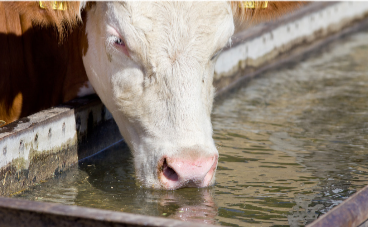Recently, Escambia County was fortunate enough to host our local livestock show. During the weeks leading up to the show, there was a lot of discussion among parents and show personnel about issues youth had experienced with their animals, including bloat, weight loss, loose manure, sickness, etc. These discussions got me thinking about ruminant nutrition for show animals. Although the discussion revolved around raising animals for show, the same feeding practices can be applied to our commercial livestock herds. We’ve often heard the saying, “you feed the microbes in the rumen, and the microbes feed the cow.” In general, there is a lot of truth to that statement. The microbes (bacteria, protozoa, and fungi population) are the rumen is the powerhouse that meets the cow’s nutritional demands. The following is a closer look at how vital maintaining rumen health is to the performance of your animals.
Let’s start with the basics; as many of you already know, cattle optimize the energy derived from fermentation in the rumen. This energy is derived from volatile fatty acids (VFA) created by the bacteria in the rumen. There are multiple types of bacteria in the rumen, and each plays a role in how healthy and efficient the rumen is at any given time. Since 80% of a cow’s energy comes from the VFA’s, keeping those bacteria happy and healthy is very important. It’s also important to note that bacteria vary in what type of feedstuffs they break down. This includes specialized bacteria for forages, protein, carbs, and more. This specialization necessitates gradual changes in diet. It takes time for the microbial populations in the rumen to adjust allowing for the efficient use of new feedstuffs. This is especially pertinent when transitioning from a forage based diet to a concentrate based diet or vise versa.
Maintaining a healthy pH in the rumen allows for an ideal environment for the bacteria to thrive. Ideally, the rumen pH should be between 5.6 and 6.3. Extremes in pH can cause bacteria to be inefficient or die. For example, if the pH is too low, microbes for fiber tend to die off, to contrast, if pH is too high, microbes for starch will die off. Therefore it’s imperative to maintain consistency in feedstuffs for cattle, and drastic changes can alter rumen activity and cause issues like scours and bloat.
A key point to remember is that the animal’s immune system relies on a healthy digestive system; in fact, almost 80% of the cow’s immune system starts at the digestive system. If the digestive system is operating normally, exposure to outside bacteria and stressors can be less drastic to the animal. If you are feeding stockers, pushing too hard can sometimes cause digestive interruptions leading to sickness and lack of feed intake. Consistencies in feeding, handling, and environment can help to lower these stressors and keep cattle on feed to maintain an optimal rumen.
Wa ter intake is also critical to efficient rumen activity and overall animal efficiency. Water intake can affect feed intake. Saliva is 98% water and cattle must use saliva to increase the moisture content of their food to swallow. Feedstuffs such as forages need to be brought to around 80% moisture and 50%-60% for concentrates. Saliva also contains sodium bicarbonate which helps mediate the rumen pH and helps control bloat. Water intake also effects many other body functions including blood and muscle formation. Water intake is also crucial for thermal regulation, needed to offset the heat generated in the body during the digestion process. If water intake is too low, feed intake and animal performance will begin to decline.
ter intake is also critical to efficient rumen activity and overall animal efficiency. Water intake can affect feed intake. Saliva is 98% water and cattle must use saliva to increase the moisture content of their food to swallow. Feedstuffs such as forages need to be brought to around 80% moisture and 50%-60% for concentrates. Saliva also contains sodium bicarbonate which helps mediate the rumen pH and helps control bloat. Water intake also effects many other body functions including blood and muscle formation. Water intake is also crucial for thermal regulation, needed to offset the heat generated in the body during the digestion process. If water intake is too low, feed intake and animal performance will begin to decline.
Rumen activity is key to cattle health and performance; when making a management decision, always consider the impact on rumen health. Since there are so many factors that can impact rumen health, it is important to talk with your feed rep, Extension Agent, veterinarian, and fellow cattlemen about ways to ensure your doing everything possible to keep those microbes happy.
–
Information derived from data provided by Dr. Jon DeClerck. For additional information on these topics, use the following links:
Rumen Protozoa: The Animals within the Cow
Water Nutrition and Quality Considerations for Cattle
- Managing Lice on Cattle - February 28, 2025
- Nutritional Demands of Beef Females Through Various Production Stages - September 6, 2024
- Recap of the 2024 Panhandle Small Ruminant Nutrition Workshop - March 15, 2024
